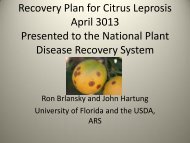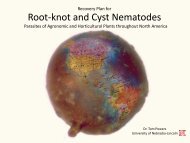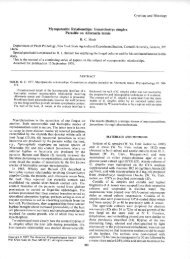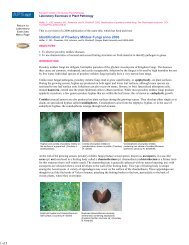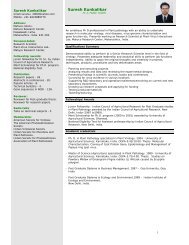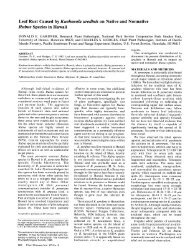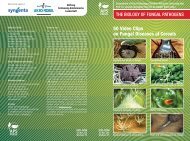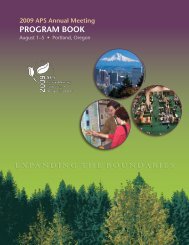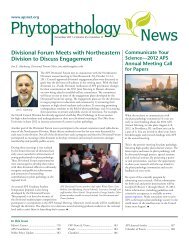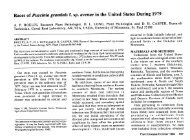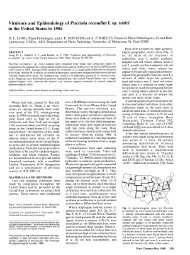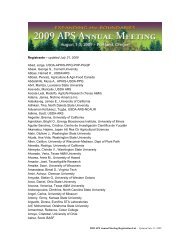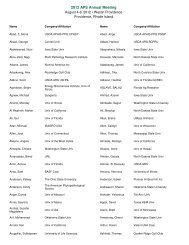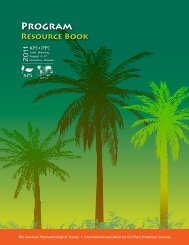view article - American Phytopathological Society
view article - American Phytopathological Society
view article - American Phytopathological Society
Create successful ePaper yourself
Turn your PDF publications into a flip-book with our unique Google optimized e-Paper software.
inaegualis has been attributed to allelic mutations in the tions were made from buds of cv. Red Haven, Crest Haven,<br />
beta-tubulin gene. To study this phenomenon at the molecular Correll and Sentinel bi-weekly from May 27 through September<br />
level, genomic DNA was isolated from 6-wk-old broth cultures 26, 1988. Buds were surface sterilized in 0.05% sodium hypoof<br />
a benomyl-sensitive (WC-S) and a benomyl-resistant (KV3C) chlorite in 10% ethanol, and plated on acid potato dextrose<br />
field isolate of V. inaequalis and partially digested with agar. Elevated isolation frequencies from 4% to 32% were<br />
the restriction enzyme Sau3A. Sucrose gradient fractionated recorded immediately after harvest for each cultivar. Cankers<br />
DNA (16-20 kb) and BamHI/EcoRI digested lambda EMBL3 DNA develop on bearing wood under the buds from December to<br />
were ligated with T4 DNA ligase and packaged to prepare a February. Twigs die immediately after bloom. Benomyl sprays<br />
library. The library was screened for clones with a hetero- (1 lb/A a.i.) on August 1 and September 1 reduced the<br />
logous Erisyphe graminis beta-tubulin probe. DNA sequence incidence of twig cankers in 1989 from 48% to 8%.<br />
analysis of the clones showed extensive sequence similarities<br />
with the probe thereby confirming that the beta-tubulin gene<br />
had been cloned. 154<br />
ISOLATION, PURIFICATION AND CHARACTERIZATION OF A PHYTOTOXIN<br />
15 ~*A.M. FROM LIQUID CULTURES OF LEUCOSTOMA PERSOONII AND L. CINCTA.<br />
Svircev, °A.R. Biggs, *N. Miles and *C. Chong.<br />
OVERWINTER SURVIVAL IN THE FIELD OF COLLETOTRICHUM *Horticultural<br />
ACUTATUM ON<br />
Research Institute 0 Ontario, Canada,<br />
of Ontario,<br />
LOR 2E0;<br />
Vineland<br />
Agriculture<br />
Station,<br />
STRAWBERRY<br />
Canada Research<br />
FRUIT IN OHIO.<br />
Station,<br />
L. L. Wilson, M. A. Ellis, and L. V.<br />
Madden, Dept. of Plant Pathology, Ohio State Univ., Wooster, OH Vineland<br />
44691.<br />
Station, Ontario, Canada, LOR 2E0.<br />
Liquid cultures of L. persoonii and L. cincta were grown in 2%<br />
Survival of Colletotrichum acutatum on infected strawberry fruit malt extract medium on a rotary shaker. Fourteen-day-old<br />
was evaluated in the was he field. valate iel. Infected Ifectd in fruit fuitwer were seaed sealed in n nylon nlon cultures separated were by ultrafiltration filtered and the into cell-free specific culture molecular filtrate size<br />
mesh bags (5<br />
was<br />
fruit/bag) and placed on and 5-8 cm beneath the soil fractions.<br />
surface<br />
Excised<br />
in Nov<br />
ltato intspefrsica<br />
1988. Both treatments<br />
shoot<br />
were<br />
tips<br />
covered<br />
(ca.i<br />
stra much.At nteval 1mo statin inDec with 8 cm of fr actin<br />
straw<br />
988onebag<br />
mulch. in wexcsed peah,<br />
At P 1-mo<br />
length) were used to test the runu crude p intervals, starting<br />
rica, fractions s<br />
in Dec<br />
oo<br />
1988,<br />
for tip<br />
one<br />
toxin<br />
bag activity. Peach<br />
from<br />
canker-like<br />
each of<br />
symptoms<br />
three replications<br />
were induced<br />
was<br />
only<br />
removed<br />
by the<br />
from on and beneath < 1,000 dalton<br />
the soil<br />
fraction.<br />
surface<br />
Further<br />
and fruit<br />
purification<br />
were assayed<br />
of the<br />
for<br />
phyto-<br />
viable C. acutatum. toxin by isoelectric<br />
From Nov<br />
focusing<br />
to Mar<br />
and<br />
1989,<br />
granulated<br />
ambient<br />
bed<br />
air<br />
electrotemperatures<br />
(above straw phoresis<br />
mulch)<br />
has<br />
ranged<br />
identified<br />
from<br />
the<br />
-18 to<br />
toxin<br />
20 C,<br />
as<br />
and<br />
a small<br />
soil temperatures<br />
polypeptide.<br />
ranged from Further purification and identification of the<br />
-3 to<br />
phytotoxin<br />
13.2 C.<br />
is<br />
C.<br />
in<br />
acutatum was recovered<br />
fruit<br />
from 100%<br />
from<br />
and<br />
on<br />
>95%<br />
and within<br />
of<br />
soil, respectively, for the first 3 mo. progress. tissue culture The program toxin is to being obtain tested peach as plants selective with agent an increased<br />
After 4 mo the fungus was recovered<br />
in the<br />
from 80 and 67% of the fruit resistance to Leucostoma spp.<br />
from on and within soil, respectively. Sampling will continue<br />
through May 1989. Results will be discussed.<br />
151 CYTOCHEMICAL PROCEDURES FOR ILLUSTRATING THE RESPONSE OF PECAN<br />
TO INFECTION BY CLADOSPORIUM CARYIGENUM. S. V. Diehl, C. H.<br />
CONTROL OF CYTOSPORA CANKER AND BACTERIAL CANKER IN A YOUNG Graves, and P. A. Hedin. Dept. of Plant Path. & Weed Sci. and<br />
SWEET CHERRY ORCHARD IN OREGON. LA. Spotts, T.J. Facteau, Crop Sci. Res. Lab, USDA, Mississippi State, MS 39762,<br />
and L.A. Cervantes. Oreg. St. Univ., Mid-Columbia Agric<br />
Research and Extension Center. Hood River, OR 97031. Several fungitoxic phenolics affect resistance in pecan to infection<br />
by C. caryigenum. Transmission electron microscopy can<br />
field study to evaluate control of Cytospora canker was be used to Tocate phenolics within leaf vacuoles. Distribution<br />
initiated in 1981 by planting sweet cherry trees cv. Bing. of phenolics within vacuoles varied depending upon the fixation<br />
Treatments included white trunk paint. 3 levels of nitrogen, procedure used. Localization and quantification of juglone,<br />
application of benomyl (1.35g/1) after dormant pruning or at isoquercitrin and condensed tannins in fresh microscopic tissues<br />
popcorn, petal fall, and shuck split. Trees were evaluated can be accomplished with the use of the Hoepfner-Vorstatz stain<br />
annually from 1982 to 1986 for active trunk cankers, and iso- and butanol-HCl and a microspectrophotometer. This technique<br />
lations made from margins of cankers. Between 1 and 7% of the showed that juglone was found consistently in higher concentratrees<br />
were infected with C. cincta each year. and 26% were tions in all greenhouse seedling leaf tissue than the other two<br />
infected by 1986. Bacterial canker, caused by Pseudomonas sy- compounds. Both infected and noninfected leaf tissue can be<br />
ringae, occurred in 13% of the trees in 1982 and 25% by 1986. compared with scanning electron microscopy. Combined use of<br />
Death of trees infected with C. cincta and P. syringae was 14 these procedures should give a composite illustration of host<br />
and 26%, respectively. Nitrogen or benomyl did not reduce response to infection by C. caryigenum.<br />
incidence of cankers. White trunk paint reduced the incidence r<br />
of both Cytospora and bacterial trunk cankers. Disease incidence<br />
was highest in trees close to an old cherry orchard. 156<br />
DIFFERENTIATION OF COLLETOTRICHUM SPP. PATHOGENIC TO STRAW-<br />
152 BERRY. P. S. Gunnell and W. D. Gubler,<br />
Pathology,<br />
Department<br />
University<br />
of Plant<br />
of California, Davis, CA 95616.<br />
PATHOGENICITY OF PHIALOPHORA SP. AND RHIZOCTONIA-LIKE<br />
ON CRANBERRY (VACCINIUM MACROCARPON).<br />
FUNGI<br />
Varney, and J. L. Peterson.<br />
L. P. Cn E.H.<br />
Plant<br />
The morphology<br />
Pathology,<br />
of both conidia and setae<br />
Rutgers<br />
produced on strawberry<br />
leaf<br />
University,<br />
piece agar<br />
New<br />
were found to<br />
Brunswick,<br />
be reliable<br />
NJ<br />
criteria<br />
08903. to<br />
distinguish Colletotrichum spp. pathogenic to strawberry. von<br />
Cranberry cuttings<br />
Arx<br />
inoculated<br />
proposedthaft<br />
with a high<br />
Cfragariae<br />
level of<br />
Brooks<br />
Phialophora<br />
was synonomnous<br />
gloeosporioides<br />
with C.<br />
developed<br />
Penz., however,<br />
severe<br />
conidia<br />
symptoms,<br />
of C. fragariae<br />
including leaf<br />
isoyellowing,<br />
lates,<br />
defoliation,<br />
including specimens<br />
desiccation,<br />
collected<br />
and<br />
by<br />
root<br />
Brooks,<br />
necrosis. Symptoms<br />
were<br />
were<br />
pre-<br />
dominantly clavate whereas<br />
significantly conidia<br />
milder of C. gloeosporioides<br />
at low inoculum were<br />
levels. Controls were predominantly cylindrical<br />
symptomless.<br />
with rounded-ends.<br />
There was a significant<br />
Conidia of<br />
difference<br />
C.<br />
in fresh fragariae<br />
weight<br />
were also<br />
and root<br />
longer<br />
length<br />
and narrower<br />
between<br />
than<br />
Phialophora-inoculated<br />
those of C.-<br />
and gloeosporioides.<br />
control Setae<br />
cuttings.<br />
of C. fragariae<br />
Rhizoctonia-like were brown,<br />
fungi<br />
several<br />
isolated from septate, somewhat<br />
cranberry<br />
sinuous,<br />
roots<br />
n-ot<br />
and<br />
tapered,<br />
shoots<br />
and<br />
had<br />
usually<br />
binucleate<br />
produced<br />
hyphae. Three conidia when mature.<br />
selected<br />
Setae<br />
isolates<br />
of C.<br />
(Rh-l,<br />
gloeosporioides<br />
Rh-2, and Rh-3)<br />
although<br />
had different modes also brown and septate,<br />
of infection.<br />
were strongly<br />
Rh-i penetrated<br />
tapered, did<br />
and<br />
not<br />
colonized<br />
produce<br />
the epidermal and conidia, and<br />
cortical<br />
were<br />
cells.<br />
finely warted<br />
Rh-2 penetrated<br />
toward the<br />
and<br />
top.<br />
produced<br />
C. acutatum<br />
typical hyphae Simmonds produced fusiform<br />
and<br />
spores<br />
monilioid and<br />
cells<br />
comparativel-y<br />
in the<br />
short,<br />
epidermis. dark<br />
Rh-3 did not penetrate brown, thick-walled setae which were usually aseptate.<br />
the epidermal cells, but colonized the root surface.<br />
153 157<br />
PHOMOPSIS BUD AND TWIG BLIGHT OF PEACH. F. F. Hendrix, Jr., RELATIONSHIP OF TEMIPERATURE TO THE FUNGI INVOLVED<br />
Department of Plant Pathology, University of Georgia, Athens, IN CRANBERRY FRUIT ROT. F.L. Caruso, Cranberry<br />
GA 30602.<br />
Experinent Station, University of Massachusetts,<br />
East Warehamn,<br />
Phomopsis<br />
MA<br />
twig<br />
02538.<br />
blight of<br />
been<br />
peach,<br />
a major<br />
caused<br />
problem<br />
by Phomopsis<br />
in North<br />
sp.,<br />
Georgia<br />
has<br />
for the last 5 years. More than<br />
The<br />
ten<br />
fungus<br />
different<br />
infects<br />
fungi<br />
through<br />
are<br />
healthy<br />
capable<br />
buds<br />
of<br />
after<br />
causing<br />
harvest. Isola- field or storage rot in cranberry fruit. Cranberriem<br />
1154 PHYTOPATHOLOGY<br />
155



